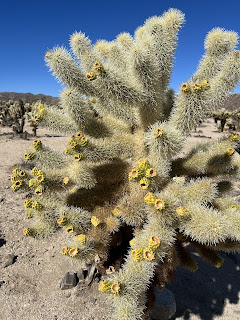The Joshua Tree area has been inhabited by humans for at least 5,000 years but by the 1920s development and cactus poachers threatened the ecosystem. Minerva Hoyt, a Pasadena, CA resident and lover of desert plants, became concerned and it was the result of her efforts to protect this area that FDR designated the 825,000 acres as a national monument in 1936.
Oh those strong, persistent women….. thank goodness we have had them throughout our history!
It was not until 1994 that that this national monument was elevated to National Park status.
We entered the park from its south entrance having traveled Box Canyon Road heading north from the Salton Sea. It was a perfect meander through the desert giving us a small peek into what was to come.
Joshua Tree National Park is an ecological melting pot - the blending of the Colorado Desert at its eastern/southern half and the Mojave Desert to the west/north. The Colorado Desert is approximately 3,000’ above sea level and the habitat is similar to the rest of the Sonoran Desert that spans much of Arizona and New Mexico with Creosote being the dominate plant mixed with large patches of Cholla cactus. It is about a 30 mile drive through this desert landscape until one reaches the “transition” zone into the Mojave.
The elevation in the Mojave Desert is above 3,000’ and climbs, at one point, to well over 5,000’ at Keys View. You know you have entered the Mojave when you finally see the Joshua trees mixed among the pinyon pines, juniper, and scrub oaks. Joshua trees are, in fact, a species of yucca and can grow to over 40’ tall. Their growth rate is surprisingly slow… 1” per year!
The Mojave is also home to the most astounding piles of stacked boulders I have ever seen! These huge rocks are composed of monzo-granite as a result of volcanic activity eons ago. Over time the granite cooled and crystallized and began its uplift to the surface. They truly look like a child’s building blocks arranged just so.
There are lots of campgrounds within the park- all of them very basic (no hook ups) and no vehicle over 35’ is allowed. We stayed at the Jumbo Rocks camp -@ halfway through the park - which was nestled among, yup, jumbo rocks. It was so quiet and the night sky was spectacular! Around 4 am I looked out the window to see the moon - a bright, almost yellow-orange grin siting just on top the boulders in the SE sky. That sliver of a moon did not lessen the brilliance of the star packed sky around it.
The next morning we were greeted by a coyote walking by; its gait an almost skip/hop.








Another glorious posting. What an experience to get to spend the night with the boulders and that sky!
ReplyDeleteI feel like I'm with you when reading your blog posts, Toni. Thank you for sharing so much more than pictures!!
ReplyDeleteGreat photos and wonderful narrative! Love the comment about the yellow orange grin…
ReplyDelete